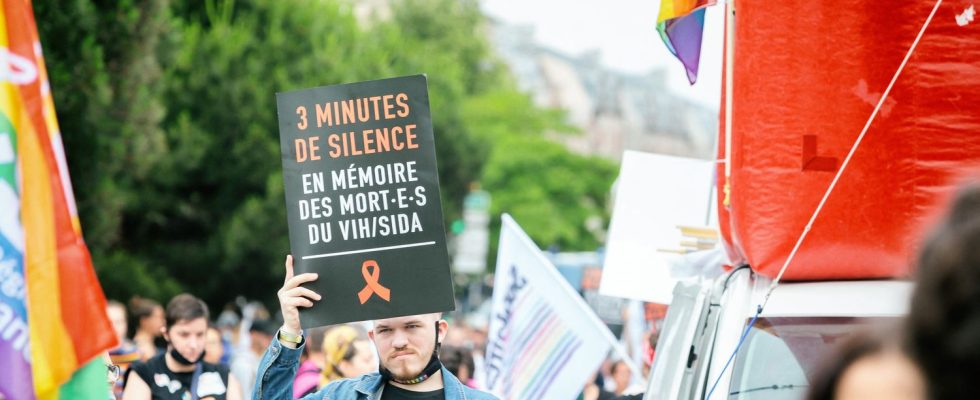The remission of a new HIV patient after a bone marrow transplant, considered “exceptional”, is a hope for research. But this is not the solution for the 39 million people affected by the virus worldwide, warn scientists and associations.
Sixth HIV patient is in remission after receiving a bone marrow transplant. His case was presented Thursday, July 20 in Brisbane (Australia), ahead of the International AIDS Society conference which will open on Sunday.
But unlike the first five people already considered probably cured of HIV – they had received a bone marrow transplant and stem cells from donors who naturally had a very rare genetic mutation preventing the virus from entering the cells – the situation is different for “the patient from Geneva”, name given to this man followed and treated in the Swiss city.
This 49-year-old patient, suffering from HIV and leukemia, benefited in 2018 from a stem cell transplant from a donor who does not carry the famous rare mutation of a gene called “CCR5 delta 32”. Franceinfo takes stock of this discovery and what it can change (or not) for the HIV epidemic, while the UN has judged, in a report published on July 13, that it was “possible” to end this epidemic as a public health threat in 2030.
Because the remission of the “patient of Geneva” is an “exceptional” case
In addition to being infected with HIV, the “patient from Geneva” had leukemia, like the five other patients before him, which required a bone marrow transplant. The results of this heavy operation “make it possible to find new avenues of research”, welcomed Asier Sáez-Cirión, head of the Viral Reservoirs and Immune Control Unit at the Institut Pasteur who followed the patient, Thursday at a press conference. “This is an exceptional case, but it is not a strategy that can be extrapolated to the nearly 40 million people living with HIV”, he recalled. This is also the opinion of Professor Olivier Bouchaud, head of the infectious diseases department at the Avicenne hospital in Bobigny (Seine-Saint-Denis).
“This is good news, but it is unfortunately anecdotal. These transplants concern six cases of possible cure out of 39 million patients.”
Olivier Bouchaud, head of the infectious and tropical diseases department at the Avicenne hospital in Bobignyat franceinfo
According to this specialist, treating infected people with a bone marrow transplant and antiretroviral monitoring is impossible and “the risk-benefit balance would lean towards the risks with serious and frequent adverse effects”.
While several hypotheses have been put forward to explain this remission, the possible role of immunosuppressive treatments (used to prevent transplant rejection) is cause for hope. “It is possible that there is an effect of the immunosuppressive treatment on the virus. It may have rendered the patient’s cells uninfectable.”judges Professor Olivier Bouchaud.
Because we are not yet talking about “cure” but of “remission”
The long remission of the patient, who stopped his antiretroviral treatment in November 2021, is considered encouraging by the scientific community. But it is out of place to mention a healing, characterized by the fact that “THE number of infected cells has drastically decreased and we are no longer able to detect them”, according to Asier Sáez-Cirión, from the Institut Pasteur. Previous “lambda” stem cell transplants have failed in the past as patients have relapsed. “A single virion [une particule virale infectieuse] can lead to a rebound of the virus”, call back to AFP SHaron Lewin, Conference Chair of the International AIDS Society.
“It takes more time and hindsight to talk about healing”, explains to franceinfo Fabrice Pilorgé, director of advocacy at the Aides association. “And if we talk about a cure, everyone will believe that we are curing HIV, which is not the case.” He judges that “ICases of HIV remission are hope for research, but not the solution.”
Because there is no vaccine or definitive treatment to date
Science is advancing, but the conclusion is always the same. “There is no preventive vaccine, no curative vaccine and no medicine to completely cure the sick”, recalls Professor Olivier Bouchaud. According to the UN, 39 million people were living with the virus worldwide in 2022.
“Testing must be intensified so that those living with HIV can access treatment and do not transmit the virus”, alert Fabrice Pilorgé, from the Aides association. Current treatments are triple therapies and PrEP (for “pre-exposure prophylaxis”), a preventive treatment that allows a seronegative person exposed to HIV to protect themselves by taking antiretroviral treatment.
Because funding seems limited for access to care on a global scale
Will we be able to beat the HIV epidemic within seven years? According to the UN, this challenge is possible with a strong political commitment and financial choices. “We have never been so close to getting there, but the States are slowing down, HIV is less of a priority than before. We need funding, and it has stagnated in recent years”, regrets Fabrice Pilorgé, from Aides. “HIV funding declined in 2022, from both domestic and international sources, falling to the same level as in 2013,” notes the UN in its report published on July 13.
“Iin order to [de l’épidémie] around 2030 seems complicated to me”, also judged on franceinfo THE Professor Yazdan Yazdanpanah, Director of the National Agency for Research on AIDS, Hepatitis and Emerging Infectious Diseases (ANRS). “Covid-19 has caused a delay in detecting the disease and in getting treatment.”
The transmission of HIV also comes up against inequalities and disparities. While the number of people on antiretroviral treatment in the world has increased from 7.7 million in 2010 to 29.8 million in 2022, the UN points out that eight countries in sub-Saharan Africa account for 65% of HIV-positive people. In addition, 143 countries criminalize or prosecute exposure to HIV, non-disclosure HIV status or the transmission of the virus, recalls the UN (PDF link). However, according to the organization, “punitive laws have been shown to impede access to HIV services and increase the risk of HIV infection.”
